
https://www.sciencebuddies.org/science-fair-projects/project-ideas/Aero_p040/aerodynamics-hydrodynamics/wind-turbine-design
- Subject:
- Career and Technical Education
- Technology and Engineering
- Material Type:
- Activity/Lab
- Date Added:
- 04/13/2024

https://www.sciencebuddies.org/science-fair-projects/project-ideas/Aero_p040/aerodynamics-hydrodynamics/wind-turbine-design
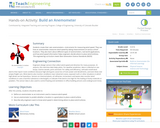
Students create their own anemometers instruments for measuring wind speed. They see how an anemometer measures wind speed by taking measurements at various school locations. They also learn about different types of anemometers, real-world applications, and how wind speed information helps engineers decide where to place wind turbines.
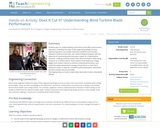
Students gain an understanding of the factors that affect wind turbine operation. Following the steps of the engineering design process, engineering teams use simple materials (cardboard and wooden dowels) to build and test their own turbine blade prototypes with the objective of maximizing electrical power output for a hypothetical situation—helping scientists power their electrical devices while doing research on a remote island. Teams explore how blade size, shape, weight and rotation interact to achieve maximal performance, and relate the power generated to energy consumed on a scale that is relevant to them in daily life. A PowerPoint® presentation, worksheet and post-activity test are provided.
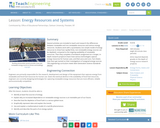
Several activities are included to teach and research the differences between renewable and non-renewable resources and various energy resources. The students work with a quantitative, but simple model of energy resources to show how rapidly a finite, non-renewable energy sources can be depleted, whereas renewable resources continue to be available. The students then complete a homework assignment or a longer, in-depth research project to learn about how various technologies that capture energy resources for human uses and their pros and cons. Fact sheets are included to help students get started on their investigation of their assigned energy source.
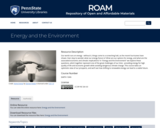
Our world runs on energy - without it, things come to a screeching halt, as the recent hurricanes have shown. Ever stop to wonder what our energy future is? What are our options for energy, and what are the associated economic and climatic implications? In \Energy and the Environment\" we explore these questions, which together represent one of the great challenges of our time - providing energy for high quality of life and economic growth while avoiding dangerous climate change. This course takes an optimistic view of our prospects, and we'll see how shifting to renewable energy can lead to a viable future.
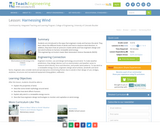
This lesson introduces the ways that engineers study and harness the wind. Students will learn about the different kinds of winds and how to measure wind direction. In addition, students will learn how air pressure creates winds and how engineers build and test wind turbines to harness energy from wind.
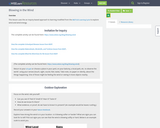
This lesson uses the an inquiry-based approach to learning modified from the BEETLES Learning Cycle to explore wind and wind energy.

Students learn and discuss the advantages and disadvantages of renewable and non-renewable energy sources. They also learn about our nation's electric power grid and what it means for a residential home to be "off the grid."
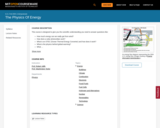
This course is designed to give you the scientific understanding you need to answer questions like: How much energy can we really get from wind? How does a solar photovoltaic work? What is an OTEC (Ocean Thermal Energy Converter) and how does it work? What is the physics behind global warming? What makes engines efficient? How does a nuclear reactor work, and what are the realistic hazards? The course is designed for MIT sophomores, juniors, and seniors who want to understand the fundamental laws and physical processes that govern the sources, extraction, transmission, storage, degradation, and end uses of energy.
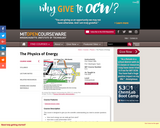
"This course is designed to give you the scientific understanding you need to answer questions like: How much energy can we really get from wind? How does a solar photovoltaic work? What is an OTEC (Ocean Thermal Energy Converter) and how does it work? What is the physics behind global warming? What makes engines efficient? How does a nuclear reactor work, and what are the realistic hazards? The course is designed for MIT sophomores, juniors, and seniors who want to understand the fundamental laws and physical processes that govern the sources, extraction, transmission, storage, degradation, and end uses of energy."
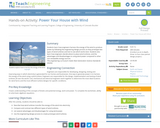
Students learn how engineers harness the energy of the wind to produce power by following the engineering design process as they prototype two types of wind turbines and test to see which works best. Students also learn how engineers decide where to place wind turbines, and the advantages and disadvantages to using wind power compared to other non-renewable energy sources.

Students are introduced to renewable energy, including its relevance and importance to our current and future world. They learn the mechanics of how wind turbines convert wind energy into electrical energy and the concepts of lift and drag. Then they apply real-world technical tools and techniques to design their own aerodynamic wind turbines that efficiently harvest the most wind energy. Specifically, teams each design a wind turbine propeller attachment. They sketch rotor blade ideas, create CAD drawings (using Google SketchUp) of the best designs and make them come to life by fabricating them on a 3D printer. They attach, test and analyze different versions and/or configurations using a LEGO wind turbine, fan and an energy meter. At activity end, students discuss their results and the most successful designs, the aerodynamics characteristics affecting a wind turbine's ability to efficiently harvest wind energy, and ideas for improvement. The activity is suitable for a class/team competition. Example 3D rotor blade designs are provided.
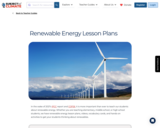
In the wake of 2021’s IPCC report and COP26, it is more important than ever to teach our students about renewable energy. Whether you are teaching elementary, middle school, or high school students, we have renewable energy lesson plans, videos, vocabulary cards, and hands-on activities to get your students thinking about renewables.

Students use real-world data to calculate the potential for solar and wind energy generation at their school location. After examining maps and analyzing data from the online Renewable Energy Living Lab, they write recommendations as to the optimal form of renewable energy the school should pursue.
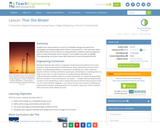
Students learn about wind as a source of renewable energy and explore the advantages and disadvantages wind turbines and wind farms. They also learn about the effectiveness of wind turbines in varying weather conditions and how engineers work to create wind power that is cheaper, more reliable and safer for wildlife.